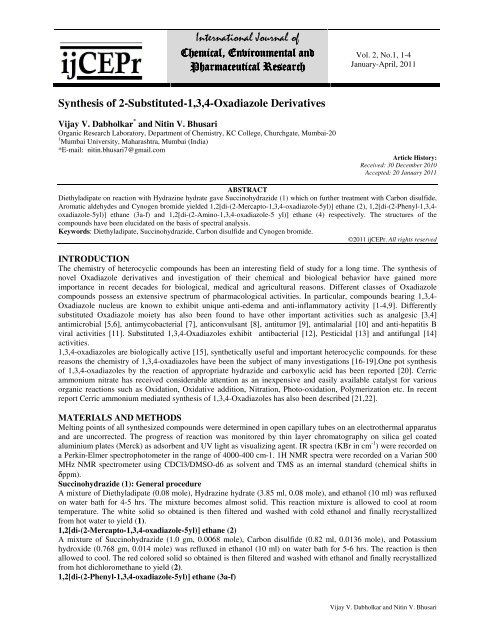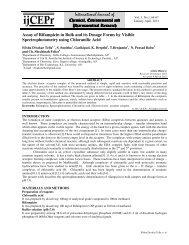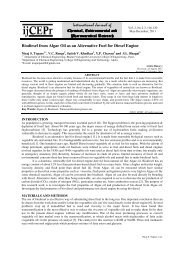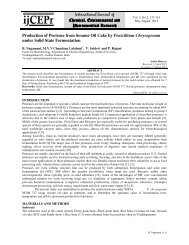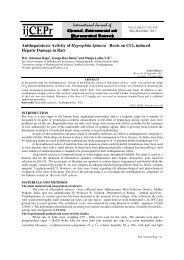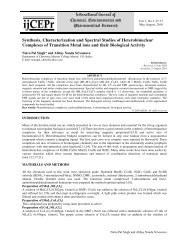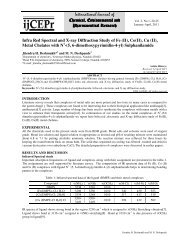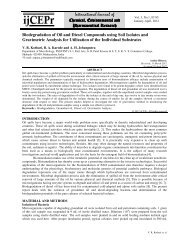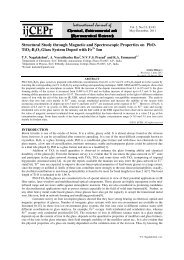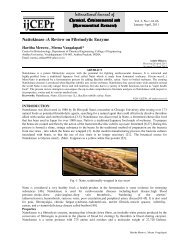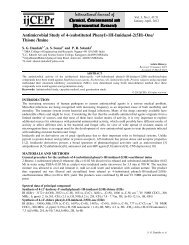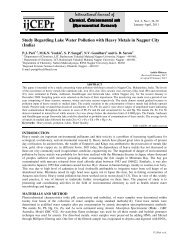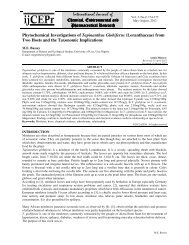Synthesis of 2-Substituted-1, 3, 4-Oxadiazole Derivatives
Synthesis of 2-Substituted-1, 3, 4-Oxadiazole Derivatives
Synthesis of 2-Substituted-1, 3, 4-Oxadiazole Derivatives
You also want an ePaper? Increase the reach of your titles
YUMPU automatically turns print PDFs into web optimized ePapers that Google loves.
International Journal <strong>of</strong><br />
Chemical, Environmental and<br />
Pharmaceutical Research<br />
Vol. 2, No.1, 1-4<br />
January-April, 2011<br />
<strong>Synthesis</strong> <strong>of</strong> 2-<strong>Substituted</strong>-1,3,4-<strong>Oxadiazole</strong> <strong>Derivatives</strong><br />
Vijay V. Dabholkar * and Nitin V. Bhusari<br />
Organic Research Laboratory, Department <strong>of</strong> Chemistry, KC College, Churchgate, Mumbai-20<br />
1 Mumbai University, Maharashtra, Mumbai (India)<br />
*E-mail: nitin.bhusari7@gmail.com<br />
Article History:<br />
Received: 30 December 2010<br />
Accepted: 20 January 2011<br />
ABSTRACT<br />
Diethyladipate on reaction with Hydrazine hydrate gave Succinohydrazide (1) which on further treatment with Carbon disulfide,<br />
Aromatic aldehydes and Cynogen bromide yielded 1,2[di-(2-Mercapto-1,3,4-oxadiazole-5yl)] ethane (2), 1,2[di-(2-Phenyl-1,3,4-<br />
oxadiazole-5yl)] ethane (3a-f) and 1,2[di-(2-Amino-1,3,4-oxadiazole-5 yl)] ethane (4) respectively. The structures <strong>of</strong> the<br />
compounds have been elucidated on the basis <strong>of</strong> spectral analysis.<br />
Keywords: Diethyladipate, Succinohydrazide, Carbon disulfide and Cynogen bromide.<br />
©2011 ijCEPr. All rights reserved<br />
INTRODUCTION<br />
The chemistry <strong>of</strong> heterocyclic compounds has been an interesting field <strong>of</strong> study for a long time. The synthesis <strong>of</strong><br />
novel <strong>Oxadiazole</strong> derivatives and investigation <strong>of</strong> their chemical and biological behavior have gained more<br />
importance in recent decades for biological, medical and agricultural reasons. Different classes <strong>of</strong> <strong>Oxadiazole</strong><br />
compounds possess an extensive spectrum <strong>of</strong> pharmacological activities. In particular, compounds bearing 1,3,4-<br />
<strong>Oxadiazole</strong> nucleus are known to exhibit unique anti-edema and anti-inflammatory activity [1-4,9]. Differently<br />
substituted <strong>Oxadiazole</strong> moiety has also been found to have other important activities such as analgesic [3,4]<br />
antimicrobial [5,6], antimycobacterial [7], anticonvulsant [8], antitumor [9], antimalarial [10] and anti-hepatitis B<br />
viral activities [11]. <strong>Substituted</strong> 1,3,4-<strong>Oxadiazole</strong>s exhibit antibacterial [12], Pesticidal [13] and antifungal [14]<br />
activities.<br />
1,3,4-oxadiazoles are biologically active [15], synthetically useful and important heterocyclic compounds. for these<br />
reasons the chemistry <strong>of</strong> 1,3,4-oxadiazoles have been the subject <strong>of</strong> many investigations [16-19].One pot synthesis<br />
<strong>of</strong> 1,3,4-oxadiazoles by the reaction <strong>of</strong> appropriate hydrazide and carboxylic acid has been reported [20]. Cerric<br />
ammonium nitrate has received considerable attention as an inexpensive and easily available catalyst for various<br />
organic reactions such as Oxidation, Oxidative addition, Nitration, Photo-oxidation, Polymerization etc. In recent<br />
report Cerric ammonium mediated synthesis <strong>of</strong> 1,3,4-<strong>Oxadiazole</strong>s has also been described [21,22].<br />
MATERIALS AND METHODS<br />
Melting points <strong>of</strong> all synthesized compounds were determined in open capillary tubes on an electrothermal apparatus<br />
and are uncorrected. The progress <strong>of</strong> reaction was monitored by thin layer chromatography on silica gel coated<br />
aluminium plates (Merck) as adsorbent and UV light as visualizing agent. IR spectra (KBr in cm -1 ) were recorded on<br />
a Perkin-Elmer spectrophotometer in the range <strong>of</strong> 4000-400 cm-1. 1H NMR spectra were recorded on a Varian 500<br />
MHz NMR spectrometer using CDCl3/DMSO-d6 as solvent and TMS as an internal standard (chemical shifts in<br />
δppm).<br />
Succinohydrazide (1): General procedure<br />
A mixture <strong>of</strong> Diethyladipate (0.08 mole), Hydrazine hydrate (3.85 ml, 0.08 mole), and ethanol (10 ml) was refluxed<br />
on water bath for 4-5 hrs. The mixture becomes almost solid. This reaction mixture is allowed to cool at room<br />
temperature. The white solid so obtained is then filtered and washed with cold ethanol and finally recrystallized<br />
from hot water to yield (1).<br />
1,2[di-(2-Mercapto-1,3,4-oxadiazole-5yl)] ethane (2)<br />
A mixture <strong>of</strong> Succinohydrazide (1.0 gm, 0.0068 mole), Carbon disulfide (0.82 ml, 0.0136 mole), and Potassium<br />
hydroxide (0.768 gm, 0.014 mole) was refluxed in ethanol (10 ml) on water bath for 5-6 hrs. The reaction is then<br />
allowed to cool. The red colored solid so obtained is then filtered and washed with ethanol and finally recrystallized<br />
from hot dichloromethane to yield (2).<br />
1,2[di-(2-Phenyl-1,3,4-oxadiazole-5yl)] ethane (3a-f)<br />
Vijay V. Dabholkar and Nitin V. Bhusari
Vol.2, No.1, 1-4 (2011)<br />
A mixture <strong>of</strong> Succinohydrazide (1.0 gm, 0.0068 mole), aromatic aldehydes (0.0136 mole), and Cerric ammonium<br />
sulphate (0.5 gm, 0.0008 mole), in Dichloromethane (10 ml) as a solvent was taken in 100 ml round bottom flask<br />
and the mixture was refluxed on water bath for 4-5 hrs. After monitoring the reaction on TLC, the reaction mixture<br />
was cooled and dumped on to the ice, filtered and recrystallized from ethanol.<br />
1,2[di-(2-Amino-1,3,4-oxadiazole-5 yl)] ethane (4)<br />
A mixture <strong>of</strong> Succinohydrazide (1.0 gm, 0.0068 mole), Cynogen bromide (0.0136 mole), and Sodium bicarbonate (1<br />
g, 0.012 mole), in ethanol (10 ml) as a solvent was taken in 100 mL round bottom flask and the mixture was<br />
refluxed on water bath for 4-5 hrs. After monitoring the reaction on TLC, the reaction mixture was cooled and<br />
dumped on to the ice, filtered and recrystallized from dimethylformamide to yield (4).<br />
The schematic data <strong>of</strong> the compound 2, 3(a-f) and 4 are listed in the Table-1.<br />
Antimicrobial evaluation<br />
Representative samples were screened for their antimicrobial and antifungal activity against gram-negative bacteria,<br />
E coli and P aeruginosa and gram-positive bacteria, S aureus, and C diphtheriae using disc diffusion method [23,24].<br />
The zone <strong>of</strong> inhibition was measured in mm and the activity was compared with standard drug. The results <strong>of</strong><br />
antibacterial screening studies are reported in Table-2.<br />
RESULTS AND DISCUSSION<br />
Diethyladipate on reaction with Hydrazine hydrate gave Succinohydrazide (1) which on further treatment with<br />
Carbon disulfide, Aromatic aldehydes and Cynogen bromide yielded 1,2[di-(2-Mercapto-1,3,4-oxadiazole-5yl)]<br />
ethane (2), 1,2[di-(2-Phenyl-1,3,4-oxadiazole-5yl)] ethane (3a-f) and 1,2[di-(2-Amino-1,3,4-oxadiazole-5 yl)]<br />
ethane (4) respectively with good yield.<br />
Further, the representative compounds were screened for their antimicrobial activity against gram negative as well<br />
as gram positive bacteria, which shows convincing activity.<br />
ACKNOWLEDGEMENTS<br />
The authors are grateful to the Principal Ms. Manju J. Nichani and Management <strong>of</strong> K.C. College, Mumbai for<br />
providing necessary facilities. Authors are also thankful to the Director, Institute <strong>of</strong> Science, Mumbai for providing<br />
spectral analyses.<br />
Table-1: Characterization <strong>of</strong> synthesized compounds 2, 3(a-f) and 4.<br />
Compd. R Mol. Formula Yield<br />
(%)<br />
m.p.<br />
(°C )<br />
Spectral data<br />
IR (KBr cm -1 )/ 1 H NMR/ 13 C NMR (ppm) in<br />
DMSO-d 6<br />
2 - C 6 H 6 N 4 O 2 S 2 52 62-64 IR (KBr): 2581 (S-H), 1363 (C=N). 1 H NMR:<br />
2.7 (t, 4H, CH 2 ), 9.7 (s, 2H, SH).<br />
[Found: C,35.27, H,2.57, N,24.35, S,27.85%.<br />
Required: C,31.30, H,2.61, N,24.35, S,27.83%.]<br />
3a C 6 H 5 C 18 H 14 N 4 O 2 68 114-115 IR (KBr): 1621-1432 (Ar), 1377 (C=N), 1 H<br />
NMR: 2.9 (t, 4H, CH 2 ),7.4 (m,10H,ArH)<br />
[Found: C,67.27, H,3.87, N,17.35%.<br />
Required: C,67.92, H,4.4, N,17.61%.]<br />
3b p-OCH 3 -C 6 H 5 C 20 H 18 N 4 O 4 71 97-99 IR (KBr): 1373 (C=N), 1142 (-OCH 3 ).<br />
H NMR: 2.9 (t, 4H, CH 2 ),3.7 (s, 6H, OCH 3 ), 6.9<br />
(d, 4H), 7.5 (d,4H). 13 C NMR: 55.3 (OCH 3 ), 72.4<br />
(CH 2 ),114.3-128.5 (Ar-C), 152.3 (C=N)<br />
[Found: C,63.29, H,4.38, N,14.42%.<br />
Required: C,63.49, H,4.76, N,14.81%.]<br />
3c p-Cl-C 6 H 5 C 18 H 12 N 4 O 2 Cl 2 56 90-94 IR (KBr): 1353 (C=N), 781 (C-Cl).<br />
[Found: C,55.31, H,3.04, N,14.21%.<br />
Required: C,55.81, H,3.1, N,14.47%].<br />
3d o-OH-C 6 H 5 C 18 H 14 N 4 O 4 61 124-127 IR (KBr): 3302 (-OH), 1308 (C=N).<br />
[Found: C,61.65, H,4.06, N,16.07%.<br />
Required: C,61.71, H,4.00, N,16.00%].<br />
2<br />
Vijay V. Dabholkar and Nitin V. Bhusari
Vol.2, No.1, 1-4 (2011)<br />
3e CH=CH-C 6 H 5 C 22 H 18 N 4 O 2 58 112-114 IR (KBr): 3021 (CH=CH), 1328 (C=N).<br />
[Found: C,70.99, H,4.53, N,15.01%.<br />
Required: C,71.35, H,4.86, N,15.14%.]<br />
3f<br />
p-OCH 3 -m-OH-<br />
C 6 H 5<br />
C 20 H 20 N 4 O 6 57 93-95 IR (KBr): 3311 (-OH), 1331 (C=N),<br />
[Found: C,58.02, H,4.77, N,13.52%.<br />
Required: C,58.25, H,4.85, N,13.59%.].<br />
4 - C 18 H 16 N 6 O 2 64 86-89 IR (KBr): 1381 (C=N), 1267 (NH 2 ).<br />
H NMR: 2.9 (t, 4H, CH 2 ), 8.9 (s, 4H, NH 2 ).<br />
[Found: C,62.10 H,4.48, N,24.06%.<br />
Required: C,62.06, H,4.59, N,24.14%].<br />
Comp.<br />
Table-2: Antibacterial Activity <strong>of</strong> compound 2, 3(a-f) and 4<br />
Gram Positive<br />
Zone <strong>of</strong> inhibition (in mm)<br />
Gram negative<br />
S.aureus C.diphtheria P.aeruginosa E.coli<br />
2 22 20 21 19<br />
3a 21 18 20 18<br />
3b 18 19 18 14<br />
3c 16 18 17 18<br />
3d 21 22 16 17<br />
3e 20 21 18 15<br />
3f 18 19 21 14<br />
4 17 21 21 16<br />
Amphicilin<br />
trihydrate<br />
26 28 24 21<br />
DMSO 0 0 0 0<br />
* Diameter <strong>of</strong> the disc was 6mm, concentration <strong>of</strong> the compounds taken was about 100 µg/mL.<br />
O<br />
C 2 H 5<br />
C 2 H 5 O<br />
O<br />
O<br />
C 2 H 5 OH<br />
NH 2 .NH 2 .H 2 O<br />
O<br />
H<br />
N<br />
NH 2<br />
H 2 N<br />
O<br />
(1)<br />
N<br />
H<br />
CS 2<br />
Ar-CHO<br />
CNBr<br />
NaHCO 3 /C 2 H 5 OH<br />
alc.KOH<br />
CAS/MDC<br />
N<br />
N<br />
N<br />
N<br />
N<br />
N<br />
O<br />
O<br />
SH<br />
SH<br />
O<br />
O<br />
R<br />
R<br />
O<br />
O<br />
NH 2<br />
NH 2<br />
N N<br />
N N<br />
(2) (3)<br />
Scheme-1<br />
N<br />
(4)<br />
N<br />
3<br />
Vijay V. Dabholkar and Nitin V. Bhusari
Vol.2, No.1, 1-4 (2011)<br />
REFERENCES<br />
1 Omar F. A., Mahfouz M.N., Rahman A.M., Eur. J Med. Chem., 31 (1996) 819<br />
2 Franski R., Asian J. Chem., 17 (2005)2063.<br />
3 Narayana B., Vijayraj K. K., Ashalatha B. V., Kumari N. S., Arch. Pharm. (Weinheim) ,338 (2005) 373.<br />
4 Amir M., Kumar S., Acta Pharm., 31 (2007) 57<br />
5 Gaonkar L. S., Rai M. K., Eur. J. Med. Chem., 41 (2006)841.<br />
6 Mishra P., Rajak H., Mehta A., J. Gen. Appl. Microbiol., 51 (2005) 133.<br />
7 Ali M. A.,Yar M. S., Bioorg. Med. Chem. Lett., 17 (2007) 3314.<br />
8 Zargahi A., Tabalabai S. A., Faizi M., Ahadian A., Navabi P., Zanganeh V., Shafiee A., Bioorg. Med.<br />
Chem. Lett., 15 (2005) 1863.<br />
9 Bezerra N. M., De-Oliveira S. P., Srivastava R. M., Da Silva, J. R. Farmaco., 60 (2005) 955.<br />
10 Zareef M., Iqbal R., De Dominquez N. G., Rodrigues J., Zaidi J. H., Arfan M., Supuran C. T., J. Enzyme<br />
Inhib. Med. Chem., 22 (2007)301.<br />
11 Tan T. M., Chen Y., Kang K. H., Bai Li Y., Lim S. G., Ang T. H., Lam Y., Antiviral Res., 71, (2006)7.<br />
12 Hui P. X., Chu H. C., Zhang Y. Z., Wang Q. and Zhang Q., Indian J. Chem., 41B (2002), 2176.<br />
13 Khanum A. S., Shashikanth S., Sudha S. B., Deepak A. S. and Shetty S. H., Pest Manag. Sci., 60 (2004),<br />
1119.<br />
14 Palaska E., Sahin G., Kelicen P., Durlu T. N. and Altinok G., J.R. Farmaco., 57 (2002) 101.<br />
15 Perez S., Lasheral B., Oset C., Carmen A., J. Heterocycl. Chem., 34 (1997) 1527.<br />
16 Hutt M. P., Elslanger E. F., Werbet M. L., J. Heterocycl. Chem., 8 (1970) 511.<br />
17 Baltazzi E., Wysocki A., J. Chem. Ind. , 31 (1963) 1080.<br />
18 Chiba T., Mitsuhiro O., J Org. Chem., 57 (1992) 1375.<br />
19 Shah V. R., Vadodaria M., Parikh A. R., Ind. J Chem., 36B (1997) 101.<br />
20 Bentiss F. and Laqrenee M., J. Heteocycl. Chem., 36 (1999), 1029.<br />
21 Minoo D., Peyman S., Mostafa B. and Mahboobeh B., Tetrahedron Lett., 47 (2006), 6983.<br />
22 Kalluraya B., Jyothi N. Rao and Sujith V. K., Indian J Heterocycl. Chem. ,17 (2008), 359.<br />
23 Cruickshank R., Duguid J. P. and Marmion B. P., Medicinal Microbiology,12th edn, Vol 11, (1975),<br />
(Churchill Livingstone, London).<br />
24 Arthington- Skaggs B. A., Motley M. and Morrison C. J., J. Clin. Microbiology, 38, (2000) 2254.<br />
[IJCEPR-139/2011]<br />
__________________________________________________________________________________________<br />
http:// www.rasayanjournal.com<br />
ISSN: 0974-1496 (Print); ISSN: 0976-0083(Online)<br />
Highlights <strong>of</strong> RASĀYAN<br />
• It is a full text open access international journal <strong>of</strong> Chemical Sciences. Covers all fields related to<br />
Chemistry.<br />
• Research papers will be published on the website and also in the printed version simultaneously.<br />
• Manuscript is reviewed and published very quickly.<br />
• Full text <strong>of</strong> the article is available on the site http://www.rasayanjournal.com all over the world.<br />
Reprints may be downloaded directly from the website.<br />
• Papers can be submitted through e-mail to rasayanjournal@gmail.com.<br />
Note:<br />
1. Authors are requested to prepare the manuscript strictly according to RJC guidelines.<br />
2. All contacts shall be by e-mail. All the authors are advised to have an email id.<br />
4<br />
Vijay V. Dabholkar and Nitin V. Bhusari


